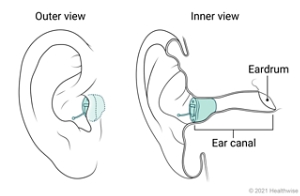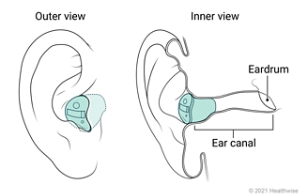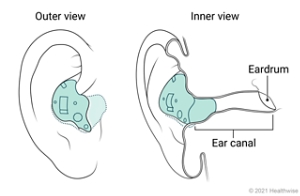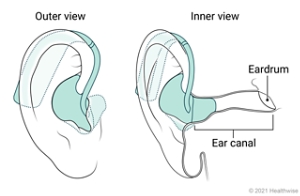Completely-in-the-canal hearing aid

The completely-in-the-canal (CIC) hearing aid is made to fit the shape and the size of the ear canal. It fits completely into the ear canal. This hearing aid can be made with special features such as a directional microphone system that can help you hear voices in a noisy room. It can be damaged by earwax and fluid draining from the ear. CIC hearing aids are used by people who have mild to moderate hearing loss. Some people find its small size hard to handle. It's not recommended for children.
In-the-canal hearing aid

The in-the-canal (ITC) hearing aid is made to fit the shape and the size of the ear canal. It fits partly into the ear canal. This hearing aid can be made with special features such as a directional microphone system that can help you hear voices in a noisy room. It can be damaged by earwax and fluid draining from the ear. ITC hearing aids are used by people who have mild to moderate hearing loss. Some people find its small size hard to handle. It's not recommended for children.
In-the-ear hearing aid

The parts of the in-the-ear (ITE) hearing aid are in a case that fits in the outer part of the ear. ITE hearing aids can be made with special features. These include a telecoil that improves hearing during phone calls and a directional microphone system that can help you hear voices in a noisy room. ITE hearing aids can be easier to handle than the smaller ITC and CIC hearing aids. It can be used by people who have mild to severe hearing loss. Children don't usually use them because the case must be replaced as the child grows.
Behind-the-ear hearing aid

Most parts of the behind-the-ear (BTE) hearing aid are in a case that fits behind the ear. The case is connected to a plastic ear mold by a clear tube that wraps around the top of your ear. BTE hearing aids can be made with special features. These include a telecoil that helps with hearing during phone calls and a directional microphone system that can help you hear voices in a noisy room. BTE hearing aids are used for all degrees of hearing loss, especially very severe hearing loss. They may be better for children for safety and growth reasons.
Mini BTE hearing aid

The mini BTE hearing aid is a smaller version of the BTE hearing aid. The parts are in a case behind the ear, but the case is smaller. The tube that connects the case to the earpiece is almost invisible. Some mini BTE aids have a very small earpiece that doesn't completely fill the ear canal. These are called "open fit" ear pieces. They are less visible than the ear molds used with BTE hearing aids. They also reduce the feeling of fullness in the ear and can be more comfortable to wear.
Current as of: October 27, 2024
Author: Ignite Healthwise, LLC Staff
Clinical Review Board
All Ignite Healthwise, LLC education is reviewed by a team that includes physicians, nurses, advanced practitioners, registered dieticians, and other healthcare professionals.

